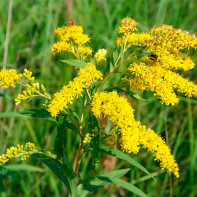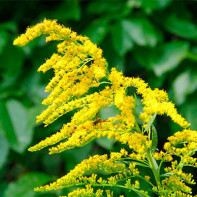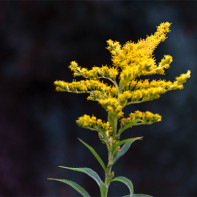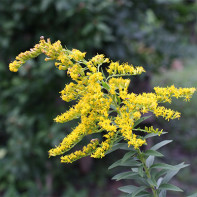Goldenrod: medicinal properties and contraindications
Goldenrod is a common plant that is perceived by many as a weed, as it has the ability to grow rapidly, capturing vast territories. But this plant is a real storehouse of nutrients. If you know how to use it correctly, collect and store it, you can get a powerful medicine that will help out with various diseases.
- Chemical composition
- How it looks and where it grows
- Kinds
- Collection and storage
- Medicinal properties of goldenrod
- For women
- For men
- During pregnancy
- Goldenrod in folk medicine: recipes
- Cold infusion
- Traditional recipe for infusion
- Decoction
- Alcohol tincture
- Root tincture
- Vodka tincture
- Tea from kidney stones
- Golden broth bath broth
- Infusion of fungal diseases
- Goldenrod Ointment
- Compresses
- Useful properties of goldenrod honey
- Contraindications
Chemical composition
Ordinary goldenrod and Canadian goldenrod are two representatives of the Goldenrod species belonging to the Astrovian family. These two species have much in common not only in botanical characteristics, but also in chemical composition. The active substances in these plants are almost identical, only the concentrations differ.

The rich chemical composition determines the pronounced therapeutic effect of taking herbal remedies, so it is important to know which components they contain. Scientists were able to study in detail the composition of these plants, so they presented a complete list of chemicals that have the ability to influence the body, treat various diseases, and also carry out prevention. The following are the most significant active components of the plant, which determine the therapeutic effect.
- Organic acids.
- Saponins.
- Phenols.
- Phenol Carboxylic Acids.
- Flavonoids (quercetin, isoramnetin, astralgaline, rutin).
- Coumarins.
- Diterpenoids and triterpinoids.
- Phytoecdysones.
- Mineral compounds.
- Vitamins - A, E, B1, K, PP.
- Polysaccharides.
- Fatty acids (in seeds).
The composition of the goldenrod is also unique because the active components contained in it, in total, give the effect of synergy, which makes the healing properties even more pronounced. Since the components of the plant complement each other, they are able to double and triple the therapeutic effect.
How it looks and where it grows
Goldenrod is common in the European part of Russia, but is found almost throughout the Eurasian continent. It is also common in western Asia. To distinguish common and Canadian goldenrod from other species is quite simple. All you need to know is the botanical characteristics of the plant.
- The rhizome is short, not recessed, of the rod type.
- The stems are straight, can reach a height of 30 to 80-100 cm.
- Leaves of an elliptical or ovoid form, stem, are arranged in the next order.
- The flowers are yellow, small, collected in baskets that form paniculate long inflorescences.
Goldenrod is an unpretentious plant, but loves moisture and plenty of sunlight. Flowering begins in late spring and continues throughout the warm season, until mid-September. By the end of September, flowering is completed, and panicle inflorescences are covered with small achenes - fruits with seeds, from which you can grow a medicinal plant in your garden if you manage to collect them before the onset of rains.
Kinds
There are over 30 varieties of goldenrod that are found in various regions of the Eurasian continent. But only 2 species are of medicinal value, as they have a rich composition, in comparison with the rest.
- Canadian goldenrod - a tall herbaceous plant, with thin straight leafy stems and panicled inflorescences of yellow color.
- Goldenrod ordinary - popularly known as the "golden rod".This is a tall plant with panicled inflorescences of yellow color, consisting of small flowers-baskets.
Plants of these species have not only a pronounced therapeutic effect, but also contain toxic substances. Therefore, it is necessary to be treated carefully, observing the dosage.
Collection and storage
In order to procure medicinal raw materials of goldenrod for the future, you need to know the basic rules. Goldenrod can be harvested in regions that are distinguished by an impeccable environmental situation. It is forbidden to collect in places where there are closely located toxic plants and factories. Also, do not collect grass in the roadside zone, where it accumulates dangerous toxins contained in the exhaust gases, as well as heavy metals with a pronounced carcinogenic effect.
In order for the obtained medicinal raw materials to be useful, you need to know when the maximum concentration of active substances accumulates in the plant. It is possible to collect medicinal raw material of goldenrod twice a year.
- In the first half of August there is a peak of flowering - this is the most suitable time to harvest goldenrod inflorescences.
- At the end of September, active substances in the highest concentration accumulate in the rhizome of the plant. This is an ideal time for digging and harvesting roots.
It makes no sense to collect the goldenrod grass - it contains the minimum amount of valuable components, in addition, after drying, it stiffens, as a result of which it is difficult to digest or evaporate useful substances from it. Therefore, it is worth cutting off only inflorescences. After cutting the tops, it is necessary to form small bunches of inflorescences, tie them up in the attic or under a canopy and dry for 2 weeks. Fully dried raw materials must be packaged for storage. You can use two methods.
- Grind the inflorescences and put them in a tin or glass jar, then close it tightly and leave it in a dry, cool room with normal humidity.
- You can not grind vegetable raw materials, but pack them in cloth bags and also store them in a dry, cool room.
The shelf life of raw materials depends on the conditions. If the air temperature is from 5 to 25 degrees, and a stable level of humidity is maintained (about 50-60%), then the obtained raw materials can be stored for 2 years. If the humidity is higher or the air temperature is unstable, the raw materials may deteriorate earlier. The best option is the annual procurement of fresh medicinal raw materials.
Medicinal properties of goldenrod
In therapeutic practice, goldenrod began to be used by doctors over 300 years ago. Today, traditional medicine does not consider plants as essential medicines, as there are many pharmaceutical products with higher efficacy. But often pharmacy products give severe side effects, and they are also not always resolved. In such situations, the use of goldenrod is more relevant than ever.
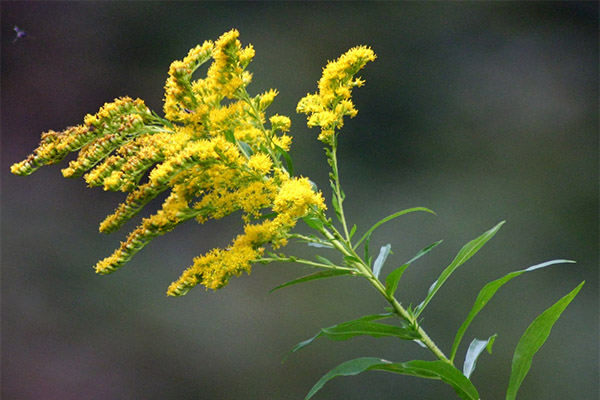
The range of medicinal properties of the plant is quite wide, since it has a rich composition. Herbal preparations prepared on the basis of this herb are capable of producing such therapeutic effects.
- Diuretic effect - to cleanse and restore the kidneys, eliminate edema.
- Anti-inflammatory property - with local and internal use. Grass reduces inflammation, and also regulates the immune response to foci of infection.
- Antibacterial and antiseptic properties - for the treatment of infectious diseases caused by pathogenic microorganisms.
- Antiviral effect - for the treatment of diseases of viral etiology (SARS, cystitis, herpes, hepatitis).
- Astringent effect - with diarrhea, as well as infectious diseases of the gastrointestinal tract. Also, these properties of the plant are used in veterinary practice - infusion of herbs is watered by animals suffering from indigestion.
- The grass also has a wound healing, regenerating effect.It is used externally and inward for scarring of ulcers, as well as for cuts, burns, infected wounds, after operations.
The benefits of this plant can be obtained only with moderate and proper use. It is also worth considering that goldenrod differently affects the female and male body. Useful properties and effectiveness are slightly different.
For women
For the female body, goldenrod is of particular value, because it has the ability to restore the functioning of the reproductive system, and also affects the hormonal background. For the treatment of diseases of the genitourinary sphere, this plant is the best option, as it contains a set of active components that can comprehensively affect the body. The medicinal properties of goldenrod can be used for such female diseases:
- candidiasis;
- bartholinitis;
- vaginitis;
- adnexitis;
- ovarian cysts and other benign formations;
- erosion.
Water infusions and decoctions from plant materials are used for douching, as well as for oral administration. When douching, it is recommended to use only a decoction, since in the process of boiling, all potentially dangerous pathogenic microorganisms die in it. Brewing and insisting herbs does not give such an effect. Most effective for infectious and fungal diseases of the genital organs, inflammatory processes, use douching and ingestion at the same time to obtain faster results.
For men
Men are not recommended to take too long treatment with this medicinal plant, as it partially inhibits the production of male hormones. But at the same time, it is invaluable in the treatment of such diseases of the reproductive system:
- erectile disfunction;
- prostatitis;
- cystitis;
- impotence.
Also, the periodic use of infusions and decoctions of goldenrod is an excellent prophylactic against inflammation of the prostate gland and oncological diseases. Periodic use of tea from this plant, as well as honey of goldenrod helps to prolong the reproductive period, increase libido and normalize hormonal levels.
During pregnancy
Herbalists categorically prohibit the use of goldenrod by women during the first trimester of pregnancy, since it carries a risk to the health and vitality of the fetus. But in the second and third trimester, you can use the medicinal potential of goldenrod, but only externally. Ingestion is contraindicated, since the effect of the active components of the herbal remedy on the embryo is not well understood.
During pregnancy, the use of goldenrod externally, as well as for rinsing the throat and oral cavity, is allowed. In case of development of ulcers on the lips, you can cauterize them with alcohol tincture of the plant. If ulcers from stomatitis formed in the oral cavity during pregnancy, you can use a weak water infusion to rinse. It is also allowed to use externally compresses, ointments. Vodka infusion is used to rub against back pain during pregnancy.
After childbirth during breastfeeding, it is also worth abandoning the use of funds based on this plant. The fact is that the toxic components of the grass penetrate into breast milk, and with it, into the body of a newborn baby. That dose, which can be safe for an adult, can cause irreparable damage to the baby.
Goldenrod in folk medicine: recipes
In alternative medicine over the previous centuries, many recipes based on goldenrod have accumulated, which have passed the test of time and showed a good coefficient of performance. Each of the recipes is good in its own way, but different options and dosage forms have their own purpose.
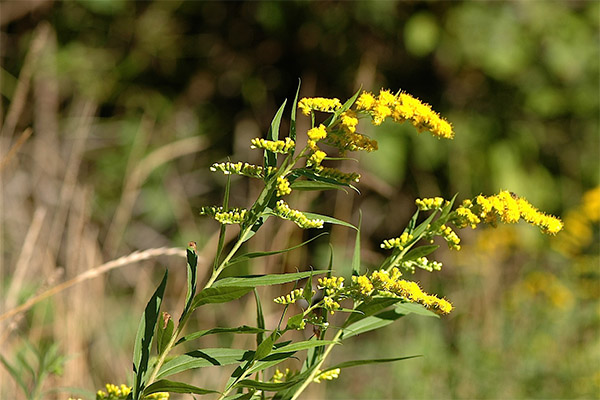
Cold infusion
The cold infusion has several advantages, so this method of preparing the medicine is very popular. To get the medicine you need to boil and cool the water. Pour with cooling water (200 ml) 1 tablespoon of plant material, cover and leave for 3-4 hours. After this, strain and take 50 ml 4 times a day.This infusion and such a treatment regimen are effective for such diseases:
- rheumatism;
- gout;
- cystitis;
- urethritis;
- inflammation of the ovaries.
Cold infusion is also useful for swelling, it accelerates the elimination of fluid from the body. You can take it in its pure form or add a little lemon juice and honey.
Traditional recipe for infusion
The simplest and fastest recipe for preparing a medicine from goldenrod is an infusion. You can cook it in two ways.
First way:
- pour boiling water over a deep bowl;
- pour in it 1 tablespoon of plant material;
- pour 400 ml of boiling water.
Take this infusion in a cooled form 2 hours after it was prepared. A single maximum dose is 50 ml. A break between receptions - at least 3 hours. It is important to combine the use of plant extract with food intake. The fact is that the bitterness that goldenrod contains activates the production of digestive enzymes and gastric juice, which can lead to discomfort, heartburn and even inflammatory processes, if you do not eat before using the medicine.
The second way:
- Pour 1 tablespoon of plant material into a thermos;
- add 400 ml of water;
- tighten and leave for 3 hours;
- strain and take 50 ml 3 times a day.
This option contains the active components in a higher concentration. The duration of treatment with goldenrod in such a dosage form is no more than 21 consecutive days. If it is necessary to continue the course, for example, with urolithiasis, 5-6 times of repetitions are necessary, then this can be done no earlier than 10 days later. During this time, the body will completely remove the remains of plant toxins.
Decoction
You can prepare a decoction from inflorescences, roots or grass of the goldenrod. You can cook from a mixture - grind the roots, mix with grass and flowers. For 2 tablespoons of this mixture, you need to take 1 liter of water. To simmer the broth for 30 minutes in a water bath. As a result, you get about 750 ml of liquid, which must be diluted with the same amount of cold boiled water. Divide the resulting liquid for 5 days, take 100 ml 3 times a day.
Decoction of goldenrod helps with such diseases:
- cystitis;
- hypertension;
- diarrhea;
- high blood sugar;
- cramping and pain;
- infectious diseases of the reproductive system;
- ulcers and wounds that heal for a long time.
The broth retains most of its useful properties, but at the same time vitamins are partially lost - when interacting with oxygen, they decompose into simpler elements and evaporate. Therefore, the broth contains a minimum of vitamins, but all other active components are present in the same concentration as in any other dosage form.
Alcohol tincture
It is desirable to prepare tincture for alcohol only from inflorescences, they absorb a maximum of valuable substances. Dried panicles of inflorescences need to be cut with scissors and put in a bottle. For each tablespoon of raw materials, take 50 ml of alcohol - this is the optimal ratio. It is necessary to allow the mixture to brew, at this time it should be placed in a dark room, you can keep it in the refrigerator door. The term for the preparation of tincture is 3 weeks. After this, strain and pour into a resealable container, store in a refrigerator or out of the reach of sunlight at a temperature of no higher than 25 degrees.
Tincture can be taken in pure form or diluted with a small amount of water. It is drunk 2-3 times a day for up to three weeks. After this, it is necessary to take a break, since the toxic substances contained in the goldenrod tend to accumulate in the body. It is necessary to take breaks between courses from 10 to 30 days.
Root tincture
At the end of September, you can go on harvesting the roots of the plant, which can be used to prepare a strong alcohol or vodka infusion. You need to take only the largest roots. They have more active substances. Especially in them there are a lot of bitterness, saponins and flavonoids.
The roots should be additionally dried to a brittle condition, and then chopped in any convenient way. You can simply break it into small pieces - hands or nippers.But it is best to grind them still fresh, and then dry the resulting slurry and use it to make tinctures. You need to prepare the medicine, observing the proportions:
- for 500 ml of vodka - 1 cup of chopped rhizome;
- 100 ml of medical alcohol (98%) - 2 tablespoons of raw materials.
Infuse roots need longer than grass and inflorescences, so it is better to send a bottle of tincture to a dark place for a month. Every 3-5 days you need to shake the container a little. After a month, the tincture should be drained through cheesecloth or a fine sieve, discard the roots, and pour the liquid into a clean dish and store in the refrigerator.
Tincture of the roots is effective in such diseases and conditions:
- otitis media (put cotton wool in the ear with tincture in the mornings and evenings);
- stomatitis (dilute with water in a ratio of 1: 3 and rinse the oral cavity);
- boils (prepare compresses);
- acne (wipe problem areas 2 times a day);
- pain (rub and use for massage).
For oral administration, it is better to use a tincture of inflorescences or herbs, and such a recipe is great for outdoor purposes. You can store the drug for no more than 2 years.
Vodka tincture
Insisting grass on vodka is no less effective, but the concentration of active substances on the same volume of tincture will be slightly lower. Therefore, vodka tincture is used in a different dosage - 20 ml (1 tablespoon) at a time. 2-3 receptions per day are possible. The duration of treatment also cannot exceed three weeks, after which a break should be made.
It is not difficult to prepare tincture with vodka - you need to take 250 ml of vodka, add 3 tablespoons of raw materials to the bottle. Leave this mixture for 2-3 weeks, occasionally shaking, so that ethanol draws out as many valuable components as possible from the grass. A ready-made tincture must be filtered, poured into a container convenient for use and stored in the refrigerator.
Tea from kidney stones
Treatment of urolithiasis is a long process that requires patience and effort. Since you have to take herbal medicine for a long time, you should limit yourself to only tea, because it contains dangerous toxins in a minimum concentration. Tea is made from ½ tablespoon of dried flowers in 250 ml of water. You just need to steam it and insist a drink for several minutes, and then drink it with sugar or honey. To achieve a pronounced effect, you need to drink such tea 3 times a day for 20 days, then take a ten-day break and repeat the course twice.
There are several rules for treating urolithiasis:
- During the course, you need to drink plenty of fluids in order to wash out salts and decay products of kidney stones from the body.
- Medicinal tea should be drunk no later than 2-3 hours before bedtime, as it has a pronounced diuretic effect.
- Do not continue treatment if the kidneys become inflamed.
- After 3 courses, it is necessary to undergo an examination to check the dynamics.
- At the time of treatment, it is worth abandoning salty, sour, fried, spicy and fatty foods.
The prognosis depends on the diameter of the stones, the general condition of the body, as well as its individual capabilities. Usually microlites are excreted when drinking tea for the first course, and for crushing larger formations it is necessary to go through a cycle of three courses from 4 to 6 times.
Golden broth bath broth
With eczema, rheumatism, inflammation and joint pain, a bath with a healing infusion is indicated. Since we are talking about large volumes of liquid, it is necessary to prepare a concentrated broth. For this it is necessary to measure dry raw materials with a jar of 500 ml. Pour grass into a pot and boil for 15 minutes with three liters of water. Leave the broth for 30-40 minutes, so that it is infused. Then strain it and add to warm water. Bath time - at least 15 minutes. The procedure must be repeated 2 times a week. You can also use this method for muscle pain, overwork.
Infusion of fungal diseases
Fungal diseases of the skin of the feet and nails are difficult to treat with pharmaceutical preparations. Usually they are used only to relieve unpleasant symptoms such as itching, redness, inflammation, and an unpleasant odor.But bathtubs with goldenrod, as well as the use of alcohol compresses give amazing results in the treatment of fungal diseases.
To prepare a medicinal infusion, you need to take 3 tablespoons of plant material and steam with 2 liters of boiling water. Insist liquid under a closed lid, and when it cools down to 40 degrees, pour into a bowl and hold in it for 10 minutes. For quick results, it is necessary to repeat the procedure daily in the evenings, and after it, wipe affected areas of the skin of the feet with apple cider vinegar diluted with soda in a ratio of 1: 1. Then put on clean cotton socks ironed. You can use foot cream, but it should be with natural Ph.
Goldenrod Ointment
If necessary, you can prepare a natural homemade ointment based on goldenrod, which is effective for skin diseases. Also, such an ointment is used to treat focal baldness, lichen, epidermophytosis, fungal diseases of the skin and nails.
To prepare an ointment from goldenrod, you will need 100 grams of pork interior fat, as well as 4 tablespoons of dry goldenrod inflorescences. It is necessary to melt the fat in a water bath, add grass. Boil for 30–40 minutes. While the fat is still liquid, you need to strain it in a resealable container and leave to cool. When the product has cooled, you can store it in the refrigerator. Ways of application:
- With irritation and peeling, rub the skin into problem areas 1 time per day.
- For focal alopecia use daily, rubbing into the scalp.
- For fungal infections of the skin, apply the ointment under a compress overnight for 2 weeks.
- Fungal nail diseases should be treated with ointment for three weeks, lubricating the affected areas 2 times a day.
The ointment can be stored in the refrigerator for more than a month, but for this you need to use it correctly. It is necessary to take a small amount of ointment for 1 procedure with a sterile spatula or a dry spoon, because when it comes into contact with fingers, bacteria will remain in it, which can ruin it ahead of time.
Compresses
Externally, using goldenrod is much more effective if you combine this with ingestion. The easiest way to externally use the healing power of goldenrod is compresses. Their use is effective in such cases:
- rheumatism (2 times a day for diseased areas);
- arthritis, pain and inflammation in the joints (every 2-3 hours for 15-20 minutes);
- eczema, inflammatory skin diseases;
- erysipelatous inflammation of the skin;
- the presence of boils and boils.
For the treatment of joints and muscle pain, a compress based on alcohol or vodka tincture is used. The alcohol tincture is diluted with water in a ratio of 1: 1, a piece of cotton cloth is moistened in it and laid on a sore spot. Vodka tincture does not need to be diluted - just moisten it with a piece of tissue and apply it to the affected area. The maximum treatment time is 30 minutes.
For skin diseases, ulcers and boils, you can use only water decoction. Preparing a decoction for compresses is necessary according to this recipe:
- Pour 3 tablespoons of inflorescences and leaves into an enameled pan;
- pour 500 ml of boiling water;
- boil;
- boil for 20-25 minutes;
- cover and let cool;
- strain the cooled liquid.
The resulting broth can be stored in the refrigerator, but before use, heat a small amount for compresses. A warm compress is many times more effective, but in the presence of wetting wounds it is better to use a decoction of room temperature, so as not to intensify the inflammatory process.
Useful properties of goldenrod honey
Goldenrod is a honeyed aromatic plant on which bees flock en masse in season. Beekeepers sometimes specially plant whole plantations of this plant in their territories in order to produce incredibly valuable medicinal honey, which has a special composition and properties. In alternative medicine, this honey is considered one of the most useful varieties for 10 diseases.
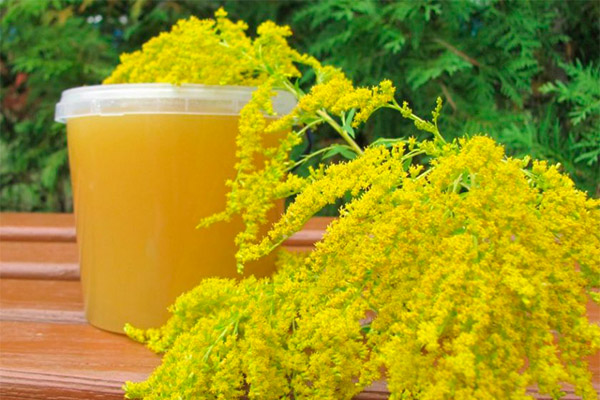
- Fungal infections are treated with honey from goldenrod many times faster and more effective than toxic pharmaceuticals.
- Goldenrod has a pronounced antibacterial and antiseptic effect, so honey from it is used for any infectious diseases of the throat, lungs and bronchi, bacterial etiology.
- Honey has a pronounced anti-inflammatory effect. It is used in inflammatory processes of various localization, both internally and externally.
- Goldenrod honey is effective for diseases of the gums and oral cavity. It helps with periodontal disease, stomatitis of various origins, herpetic infection. The product is able to quickly relieve inflammation, dry ulcers on the mucous membrane.
- Due to the diuretic effect, honey is effective for kidney diseases. It can be used in combination with herbal tea or goldenrod infusion.
- The use of honey is recommended for hypertension. It contains substances that relieve high-pressure attacks, increase the elasticity of blood vessels, and also protect the cardiovascular system as a whole.
- Goldenrod honey is a powerful tool to strengthen the immune system, it is used even for children from the age of three. To clarify whether it is possible to give a child goldenrod honey, it is necessary at the pediatrician, as there may be an allergic reaction.
- Goldenrod honey is mixed with grated onions and used for boils for compresses.
- The product is good for skin diseases, non-healing wounds. It is used in the postoperative period, so that the sutures heal faster.
- In combination with propolis, goldenrod honey is used for neuralgia, pinched nerves, vertebral hernias.
Goldenrod honey is obtained in the fall. It has a tart floral-herbal aroma, similar to the smell of honey from summer herbs. But at the same time, goldenrod honey is different in color and properties. In a liquid state, it has a caramel hue, and when it thickens, it becomes brown, like burnt sugar.
Contraindications
Goldenrod is a potent medicinal plant, which, if there are contraindications, can lead to serious negative health consequences. Therefore, you need to take it as carefully as possible. It is strictly forbidden to use this plant, even in small doses, in the presence of such contraindications:
- children under 12 years old;
- pregnancy;
- breast-feeding;
- heart failure;
- severe stages of urolithiasis;
- gastrointestinal diseases in the acute stage;
- glomerulonephritis;
- individual intolerance, allergy to the plant.
Goldenrod preparations contain toxic natural components that give a load to the liver. To avoid intoxication, it is necessary to strictly observe the dosage, and also with caution to use the medicine for liver failure. It is important in case of overdose symptoms to immediately rinse the stomach, drink enterosorbent and consult a doctor. Here are the main signs of an overdose:
- vomiting and nausea;
- diarrhea;
- acute abdominal pain;
- bloating;
- dizziness;
- cardiopalmus;
- excessive sweating;
- sleep disturbance;
- tremor.
Overdose is a dangerous condition that can pass without consequences only if measures have been taken in a timely manner to remove toxic components from the body.
Knowing the features of using goldenrod, as well as its healing potential, everyone will be able to use this medicinal plant in order to improve, treat and prevent diseases.
«Important: all information on the site is provided exclusively in fact-finding purposes. Before applying any recommendations, consult with a profile specialist. Neither the editors nor the authors are liable for any possible harm caused materials. "

